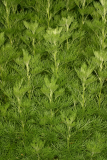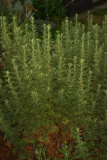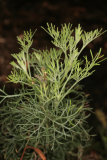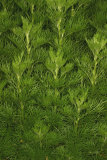Additional notes (click to expand)
Commemorative
Artemisia: after the Greek goddess Artemis who so benefitted from a plant of this family that she gave it her own name. This was also the old Latin name given to the mugwort or wormwoods. An alternative possibility for the derivation of this name is that it comes from Queen Artemisia of Halicarnassus in Asia Minor (Turkey), sister and wife of King Mausolus, who ruled after his death from 352 to 350 B.C.E. and built during her short reign one of the Seven Wonders of the Ancient World, the Mausoleum at Halicarnassus, which she unfortunately did not live to see the completion of. This is one of the many genera which Swedish botanist Carl Linnaeus published in his Species Plantarum in 1753 and is in the family Asteraceae.
http://www.calflora.net/southafrica/1A-B.html
Medicinal
Culpeper: ‘Abrotanum mas, foemina. Southernwood, male and foemale.... resists poison, kills worms, provokes lust; outwardly in plaisters it dissolves cold swellings, and helps the bitings of venomous beasts, makes hair grow.’
Culpeper, Nicholas. (1650). A Physical Directory . London, Peter Cole.
It is used as a tea in Southern Europe and parts of Asia; its antihelminthic activity is due to coumarin glycosides. As with many poisons and medicines, it is necessary to find the dose that kills the worms and not the patient.
Oakeley, Dr. H. F. . (2013). The Gardens of the Pharmacopoeia Londinensis.
link
Nomenclature
SOUTHERNWOOD; BOY'S LOVE; LAD'S LOVE; OLD MAN; MAIDEN'S RUIN; MAID'S LOVE; MAID'S PASSION; MEDICINAL WORMWOOD; SABBATH DAY POSY; SLOVENWOOD; SWEET BENJAMIN
Sowthernwode
Frisk, G. (1949). A Middle English Translation of Macer Floridus de Viribus Herbarum. Almquist & Wiksells Boktryckeri AB, Uppsala. p.59
Other use
Historical from Macer's Herbal
As a plaster for swollen sinews; As a decoction for difficulty in breathing
Drunk raw with wine for the cough, sore loins and disorders ('greuaunces') of the pudenda
As a diuretic and for getting rid of (bladder) stones
Kills intestinal worms, stops menstruation, and stops the pains and diseases of the hip bone.
Cures fistulas; Repels serpents by its smell, and drunk it destroys the venom of serpents
For a cold fever, drunk with water or soaked in cummin oil and anointed on the limbs.
With bread crumbs and apples for eye problems. As a plaster for thorns. Laid under the pillow to encourage one to lechery, drunk to abate lechery and cure gout
Frisk, G. (1949). A Middle English Translation of Macer Floridus de Viribus Herbarum. Almquist & Wiksells Boktryckeri AB, Uppsala. page 59-60
Historical from Turner's New Herball (1551)
Seed, crushed and drunk in hot water, is good for sciatica, stopping urinary incontinence and periods. With wine it is good against poison. The herb in the bed, and smoke from burning it, keeps serpents away. Drunk it treats snake, spider and scorpion bites. 'It kills worms, for it is bitter'.If burnt and mixed with Ricinus and applied topically it makes beards grow quickly. Placed under a man's pillow it 'provoketh men to the multiplying of their kind ... which by charming are not able to exercise the work of generation'.
Turner, William. (1989). A New Herball, Mid NAG & Carcanet Press. Chapman, GTL, Tweddle, MN. Facsimile 1551 ed page 33
Toxicity
Contains coumarin glycosides.
Oakeley, Dr. H. F. . (2013). The Gardens of the Pharmacopoeia Londinensis.
link
Contains thujone which can be toxic if ingested in large amounts, but the risk is low.
Professor Anthony Dayan, 2021
Geographical distribution
- Asia-Temperate, Caucasus
- Asia-Temperate, Western Asia, Turkey
- Europe, Eastern Europe, Ukraine
- Europe, Southeastern Europe, Albania
- Europe, Southeastern Europe, Bosnia and Herzegovina
- Europe, Southeastern Europe, Yugoslavia
Artemisia abrotanum L.
Family: ASTERACEAEGenus: Artemisia
Species: abrotanum L.
Common names: Southern Wormwood; Lad's Love
Pharmacopoeia Londinensis name: Abrotanum
Distribution summary: S.E. Europe, Turkey, Caucasus
Habit: Shrub
Hardiness: H5 - Hardy; cold winter
Garden status: Currently grown
Garden location: Pharmacopoeia Londinensis 1618 'Leaves' (HSE 5), Europe & Middle East (J), Pharmacopoeia Londinensis 1618 'Leaves' (HSE 6)
Flowering months: July, August
Reason for growing: Medicinal
.jpg)




.JPG)
.JPG)
.JPG)